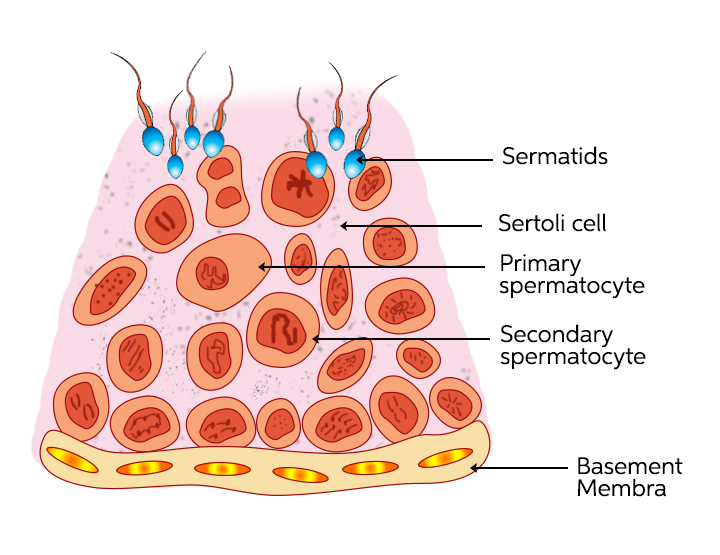
Sertoli cells are found in testis. These cells are
(a) nurse cells
(b) Reproductive cells
(c ) Receptor cells
(d) None of the above
Answer
505.2k+ views
Hint: Sertoli cells form a crucial microenvironment for the production of spermatozoa in the process of spermatogenesis.
Complete answer:
Sertoli cells are commonly known as nurse cells, situated in the seminiferous tubules of the testis. Within the seminiferous tubules, these large cells are interspersed with spermatogonia and extend from the periphery of the tubules to the lumen. The function ranges from providing nutrition to providing structural support to sperms.
Additional Information:
The process of spermatogenesis gives rise to sperms in seminiferous tubules from immature germ cells called spermatogonia. They divide by mitosis and to increase their number, but some of these cells divide by meiosis to form primary spermatocytes. These spermatozoa on further divisions give birth to spermatozoal cells which are sperms or male gametes in males. Upon maturity, these are discharged into the lumen of the seminiferous tubules. Sertoli cells support and nourish other cells. In the process of differentiation into spermatozoa, most of the spermatid cytoplasm is discarded as residual bodies, which are phagocytosed by Sertoli cells. They also secrete essential hormones such as
-Inhibin: It keeps in check the increase of testosterone in the testis.
-androgen-binding-protein (ABP) – It helps to maintain the high concentration of testosterone, required for spermatogenesis to occur.
So, the correct answer is ‘nurse cells.’

Note: FSH hormone checks the proliferation of the number of Sertoli cells in the seminiferous tubules. It also induces Sertoli cells to release ABP( Androgen binding protein). FSH or follicle-stimulating hormone is a pituitary gland hormone discharged from the anterior pituitary. Testosterone is secreted by Leydig cells located between the seminiferous tubules.
Complete answer:
Sertoli cells are commonly known as nurse cells, situated in the seminiferous tubules of the testis. Within the seminiferous tubules, these large cells are interspersed with spermatogonia and extend from the periphery of the tubules to the lumen. The function ranges from providing nutrition to providing structural support to sperms.
Additional Information:
The process of spermatogenesis gives rise to sperms in seminiferous tubules from immature germ cells called spermatogonia. They divide by mitosis and to increase their number, but some of these cells divide by meiosis to form primary spermatocytes. These spermatozoa on further divisions give birth to spermatozoal cells which are sperms or male gametes in males. Upon maturity, these are discharged into the lumen of the seminiferous tubules. Sertoli cells support and nourish other cells. In the process of differentiation into spermatozoa, most of the spermatid cytoplasm is discarded as residual bodies, which are phagocytosed by Sertoli cells. They also secrete essential hormones such as
-Inhibin: It keeps in check the increase of testosterone in the testis.
-androgen-binding-protein (ABP) – It helps to maintain the high concentration of testosterone, required for spermatogenesis to occur.
So, the correct answer is ‘nurse cells.’

Fig-Sertoli cells
Note: FSH hormone checks the proliferation of the number of Sertoli cells in the seminiferous tubules. It also induces Sertoli cells to release ABP( Androgen binding protein). FSH or follicle-stimulating hormone is a pituitary gland hormone discharged from the anterior pituitary. Testosterone is secreted by Leydig cells located between the seminiferous tubules.
Latest Vedantu courses for you
Grade 10 | CBSE | SCHOOL | English
Vedantu 10 CBSE Pro Course - (2025-26)
School Full course for CBSE students
₹37,300 per year
Recently Updated Pages
Master Class 11 Economics: Engaging Questions & Answers for Success

Master Class 11 Business Studies: Engaging Questions & Answers for Success

Master Class 11 Accountancy: Engaging Questions & Answers for Success

Master Class 11 English: Engaging Questions & Answers for Success

Master Class 11 Computer Science: Engaging Questions & Answers for Success

Master Class 11 Maths: Engaging Questions & Answers for Success

Trending doubts
State and prove Bernoullis theorem class 11 physics CBSE

1 ton equals to A 100 kg B 1000 kg C 10 kg D 10000 class 11 physics CBSE

State the laws of reflection of light

One Metric ton is equal to kg A 10000 B 1000 C 100 class 11 physics CBSE

1 Quintal is equal to a 110 kg b 10 kg c 100kg d 1000 class 11 physics CBSE

Difference Between Prokaryotic Cells and Eukaryotic Cells




